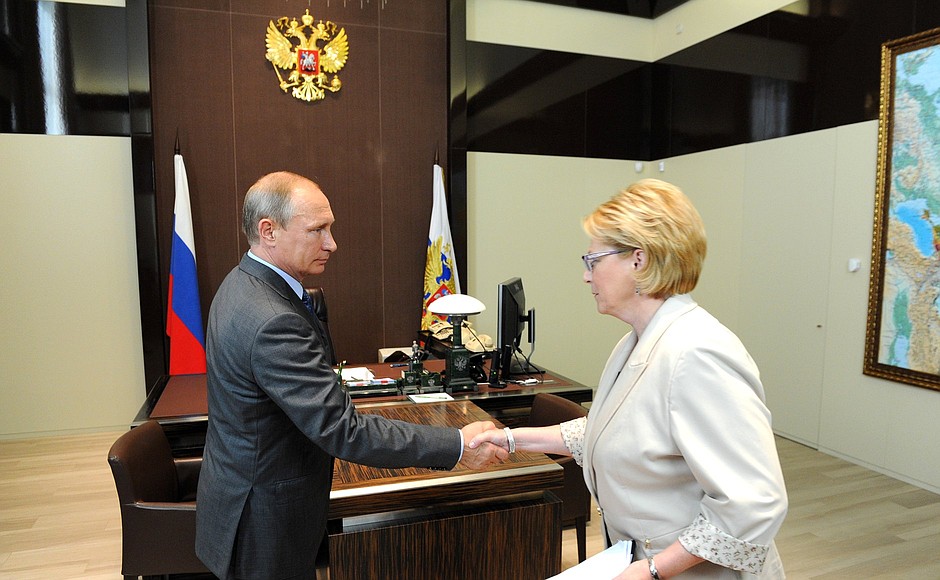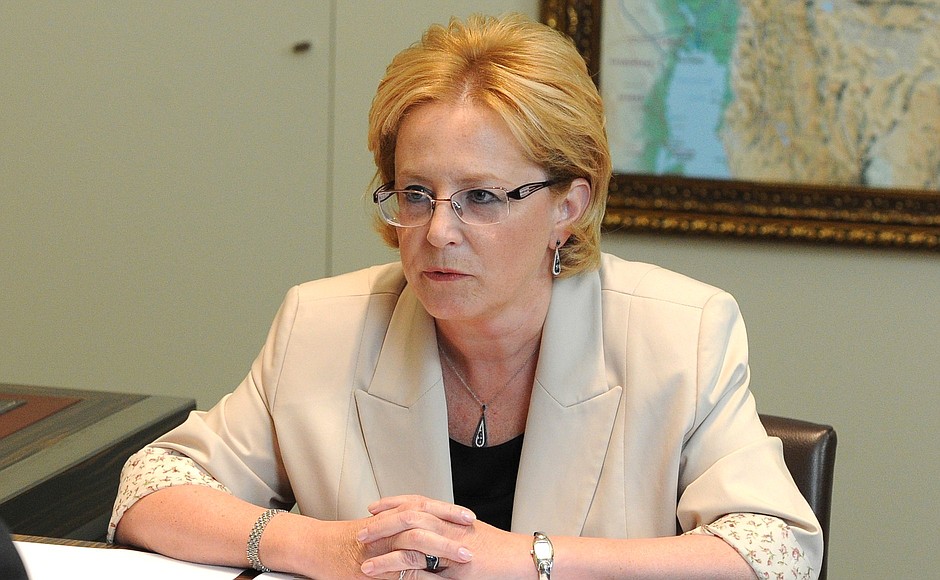President of Russia Vladimir Putin: Ms Skvortsova, you know that the Russian Popular Front will examine the healthcare system’s development at its upcoming conference. We agreed to meet before this event to discuss the sector’s development and look at the problems and proposed solutions. Please, go ahead.
Healthcare Minister Veronika Skvortsova: Yes, Mr President, the upcoming conference is a good reason to once again analyse the overall situation. By coincidence, several major sociological surveys were completed in July, and they gave us further material for analysing different aspects of the medical system and the healthcare sector in general.
The biggest survey covered more than 90,000 people throughout the country, giving us a very representative picture. The results showed that more people are satisfied now with the state of the medical system and healthcare. The number of satisfied people came to 40.4 percent, which is 10.5 percent higher than in 2006, and 5 percent higher than in 2012. People were increasingly satisfied with all types of medical care, but the figures were highest for local general practitioners and emergency services.
The differences were quite big from one region to another. The highest figure was 61.5 percent and the lowest figure was 23 percent. Overall, the trend is good, and we are pleased to see this, but at the same time, we realise that there is still a lot of work to do to improve the situation.
In July 2015, the Public Opinion Foundation (FOM) conducted another big survey. This foundation has the longest experience at carrying out surveys of this kind, and its results confirm those of the other survey. In July 2015, 45 percent of respondents said they were happy with the healthcare system. In 2012, the figure was 31 percent, and in 2006, it was 26 percent.
Among other points I would note the following: for a long time, quite a large number of people gave a negative assessment of the current state of affairs in the healthcare sector, but this figure has almost halved since 2011, falling from 58 percent to 32 percent. The second point I would note is a considerable increase in people’s trust in state-run medical organisations. This figure has increased from 52 percent to 65 percent. This year, 81 percent of people turned to state healthcare establishments, and of course, everyone prefers the system of free medical care within the compulsory medical insurance framework.
Looking at the quality of medical assistance – diagnosis and treatment – the figures here are also high, and have gone up from 78 percent to 93–95 percent.
One question that produced interesting results was whether people give priority to the quality of medical assistance, even if it means travelling to another region or town to get the specialised treatment needed, or to having access to medical services locally. Fifty-five percent of people, regardless of whether they live in cities or the countryside, give priority to the quality of medical care.
Accessibility of medical care was the subject of a special analysis. More than 88 percent of respondents said that they receive primary outpatient and clinical medical care locally (55 percent) or within 30 minutes by transport. Nearly 80 percent of respondents said that waiting times for scheduled treatment at clinics and visits to specialist doctors do not exceed the regulation times. We introduced these waiting time regulations in 2013 and made them compulsory in 2014.
The final aspect I want to note regards fee-paying and free medicine. There were two questions here. The first was “Did you pay for medical care last time you saw a doctor?” Here, 82–88 percent of respondents answered “No.” When asked if they have paid for medical care in the past, 46 percent of respondents said “Yes”, and 40 percent of this total paid officially.
This is a separate issue that we are examining very closely. Acting on your instruction, over the last 1.5 years, we have been actively informing the public about which services should be free and what is covered by the state guarantee system.
We have also toughened up our checks. The Federal Service for Surveillance in Healthcare and the Federal Compulsory Medical Insurance Fund revealed around 1.5 million violations last year, concerning cases of people having to pay upfront for what the state has already paid for. But this is not a big figure – 0.1 percent of 1.5 billion visits to healthcare establishments.
Finally, according to the survey results, the number of people who take a responsible attitude to their own health and look after themselves has increased by 20 percent since 2012. This is the respondents’ own assessment. The number of people who consider themselves to be in good health has also increased by 12 percent.
When we analysed the results from all the surveys, we saw that the same issues came up in all of them as being of most concern to the population. The three biggest concerns are having access to primary medical care in rural and remote areas, being able to receive good quality free medical care in hospitals in the event of serious illness, and access to an affordable and broad range of medicines.
With your permission, I will give a brief account of each of these three issues, what we have done, what problems remain, and what we plan to do over the coming period.
<…>


